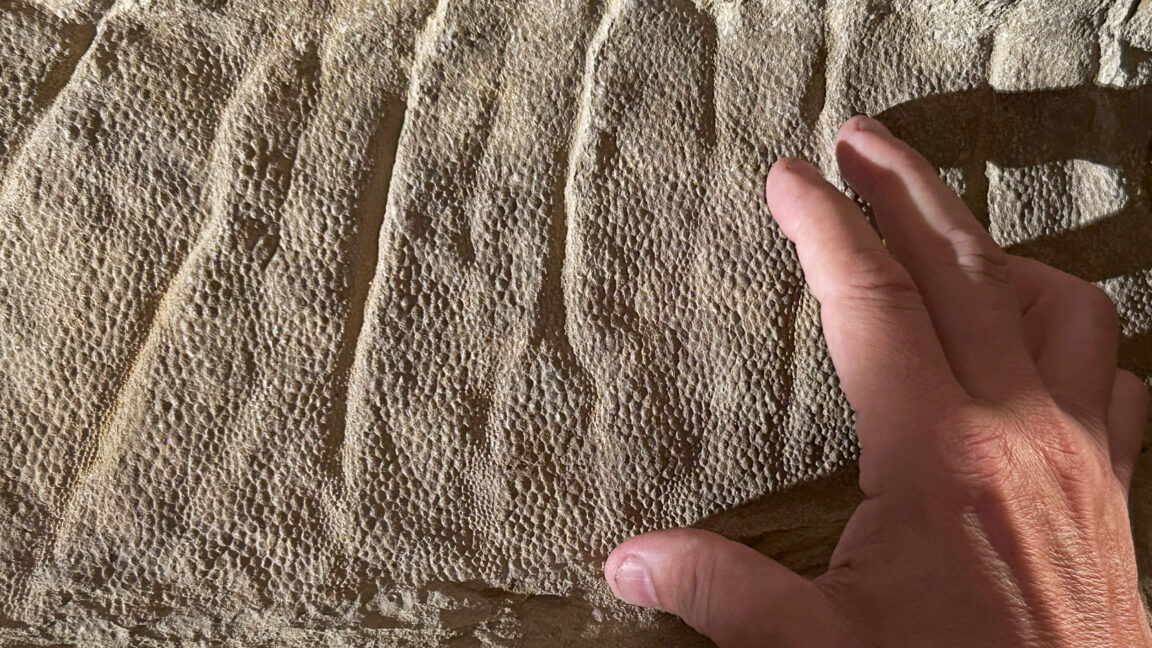Science
New Discoveries of Edmontosaurus Mummies Transform Dinosaur Science

A recent exploration in east-central Wyoming has yielded significant findings about the duck-billed dinosaur, Edmontosaurus annectens. A team of paleontologists led by Paul C. Sereno from the University of Chicago has uncovered two well-preserved dinosaur mummies that provide unprecedented insights into the species’ physical appearance. These discoveries come more than a century after the first Edmontosaurus specimen was found in 1908 by fossil collector C.H. Sternberg.
The original skeleton, known as the “AMNH mummy,” is housed at the American Museum of Natural History in New York. It was notable for its scaly skin impressions, offering an early glimpse into the dinosaur’s anatomy. The recent findings, however, represent a leap forward in paleontological knowledge, as they reveal intricate details, including the precise arrangement of scales and spikes on the tail, thanks to imprints found in a thin layer of clay.
Uncovering the Mummy Zone
The research team retraced Sternberg’s steps to identify the original excavation site. This task proved challenging, as many of the towns mentioned in Sternberg’s notes have since disappeared. Through interviews with local farmers, Sereno’s team successfully located the “mummy zone,” an area less than 10 kilometers in diameter that is rich in Cretaceous fossils.
The fossils are situated within the Lance Formation, a geological formation dating back to the final million years of the Cretaceous period. Its thickness can reach up to 1,000 meters in the mummy zone, a significant increase compared to the average thickness of 200 meters across the wider formation. Sereno attributes this thick sedimentation to frequent flooding by a nearby river, which likely buried the dinosaurs under mud and clay, preserving their features through a process known as clay templating.
Sereno explains, “Clay templating is where the clay sticks to the outside of the skin and preserves a very thin layer, a mask, showing how the animal looked.” This method has long been recognized in studies of deep-sea invertebrates, but its application to large dinosaurs had not been explored until now.
Advanced Imaging Techniques Reveal New Details
Using modern imaging techniques such as CT scans, X-rays, and photogrammetry, the research team created a detailed model of the Edmontosaurus skin. This updated portrayal reveals significant changes in the dinosaur’s appearance, including alterations to the crest and spikes, as well as the surprising discovery of hoof-like structures on its legs.
Sereno notes that the fleshy crest extends from the head along the spine and transforms into a row of spikes, contradicting earlier interpretations. The new findings indicate that the scales of Edmontosaurus were smaller than previously thought, measuring just 1 to 4 millimeters across, akin to those of a lizard, despite the dinosaur’s sizable frame.
The study also highlights the unique hoof structure of Edmontosaurus. The forelimbs featured central hooves similar in appearance to those of modern horses, while the hind legs bore three wedge-shaped hooves supporting the animal’s weight. This revelation marks a significant moment in the understanding of dinosaur physiology, as it suggests that hoof-like structures were not exclusive to mammals.
Sereno’s enthusiasm for these discoveries extends beyond Edmontosaurus. The team has also identified additional mummies in the same zone, including a T. rex and a Triceratops. The T. rex mummy was found in a lifelike pose, suggesting it may have been buried alive, while the Triceratops mummy displayed significantly larger scales and thicker skin.
As Sereno puts it, “We are in the age of discovery. There are so many things to come. It’s just the beginning.” The ongoing exploration in the mummy zone promises to yield further insights into the lives and appearances of these magnificent creatures, transforming our understanding of dinosaur biology.
The findings from this research are expected to be published in upcoming papers, with significant implications for the study of dinosaur evolution and anatomy.
-

 Science3 months ago
Science3 months agoToyoake City Proposes Daily Two-Hour Smartphone Use Limit
-

 Top Stories3 months ago
Top Stories3 months agoPedestrian Fatally Injured in Esquimalt Collision on August 14
-

 Health3 months ago
Health3 months agoB.C. Review Reveals Urgent Need for Rare-Disease Drug Reforms
-

 Technology3 months ago
Technology3 months agoDark Adventure Game “Bye Sweet Carole” Set for October Release
-

 World3 months ago
World3 months agoJimmy Lai’s Defense Challenges Charges Under National Security Law
-

 Lifestyle3 months ago
Lifestyle3 months agoVictoria’s Pop-Up Shop Shines Light on B.C.’s Wolf Cull
-

 Technology3 months ago
Technology3 months agoKonami Revives Iconic Metal Gear Solid Delta Ahead of Release
-

 Technology3 months ago
Technology3 months agoApple Expands Self-Service Repair Program to Canada
-

 Technology3 months ago
Technology3 months agoSnapmaker U1 Color 3D Printer Redefines Speed and Sustainability
-

 Technology3 months ago
Technology3 months agoAION Folding Knife: Redefining EDC Design with Premium Materials
-

 Business3 months ago
Business3 months agoGordon Murray Automotive Unveils S1 LM and Le Mans GTR at Monterey
-

 Technology3 months ago
Technology3 months agoSolve Today’s Wordle Challenge: Hints and Answer for August 19









